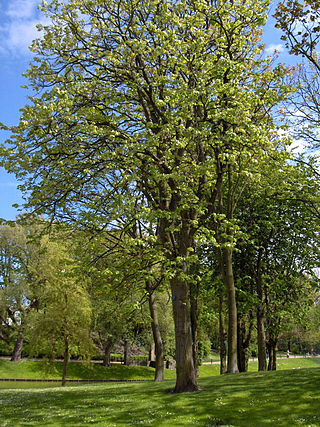
Tilia platyphyllos, the large-leaved lime or large-leaved linden, is a species of flowering plant in the family Malvaceae (Tiliaceae). It is a deciduous tree, native to much of continental Europe as well as southwestern Great Britain, growing on lime-rich soils. The common names largeleaf linden and large-leaved linden are in standard use throughout the English-speaking world except in the British Isles, where it is known as large-leaved lime. The name "lime", possibly a corruption of "line" originally from "lind", has been in use for centuries and also attaches to other species of Tilia. It is not, however, closely related to the lime fruit tree, a species of citrus.

Ficus benjamina, commonly known as weeping fig, benjamin fig or ficus tree, and often sold in stores as just ficus, is a species of flowering plant in the family Moraceae, native to Asia and Australia. It is the official tree of Bangkok. The species is also naturalized in the West Indies and in the states of Florida and Arizona in the United States. It is one of the most common trees in Israeli cities and parks. In its native range, its small fruit are favored by some birds.

Corylus maxima, the filbert, is a species of hazel in the birch family Betulaceae, native to southeastern Europe and southwestern Asia, from the Balkans to Ordu in Turkey.

Cotinus, the smoketree or smoke bush, is a genus of seven species of flowering plants in the family Anacardiaceae, closely related to the sumacs (Rhus).

Eriostemon is a genus of flowering plants of the family Rutaceae. It is native to eastern Australia and includes just two species, E. australasius and E. banksii. Eriostemon australasius, commonly known as pink wax flower, occurs between Fraser Island and Nowra and is a shrub of heathlands and low open woodlands. Eriostemon banksii is endemic to Cape York Peninsula and is a shrub or small tree occurring in heathland and rainforest margins.

Grevillea banksii, commonly known as Banks' grevillea, Byfield waratah, red flowered silky oak and dwarf silky oak, and in Hawaii as kāhili flower, is a species of flowering plant in the family Proteaceae and is endemic to Queensland. It is an erect shrub or slender tree with divided leaves with four to twelve narrow lobes, and creamy white to bright scarlet and yellow flowers.
Cabbage tree is a common name for several plant species:

Salix cinerea is a species of willow native to Europe and western Asia.

Streblus asper is a tree known by several common names, including Siamese rough bush, khoi, serut, and toothbrush tree. It is a medium-sized tree native to dry regions in Indonesia, Cambodia, Thailand, India, Sri Lanka, Malaysia, and Vietnam.
The greater Brisbane area of Queensland Australia, has many species of indigenous flora. This article links the flora to its geography with:

Streblus is a genus of flowering plants in the mulberry family, Moraceae. It includes five species native to the Indian subcontinent, Indochina, southern China, and Malesia.
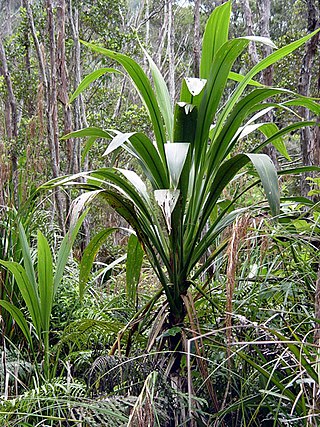
Cordyline banksii is a monocot tree endemic to New Zealand. The specific epithet banksii refers to the 18th-century botanist Joseph Banks.
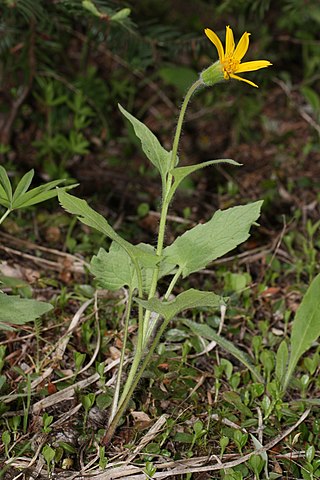
Arnica cordifolia is a species of arnica in the sunflower family, known by the common name heartleaf arnica. It is native to western North America.

Paratrophis pendulina is a species of flowering plant in the mulberry family, Moraceae. In Australia it is commonly known as whalebone tree, and other common names include the white handlewood, axe-handle wood, grey handlewood and prickly fig. In Hawaii it is known as Hawai'i roughbush or aʻiaʻi in Hawaiian.

Grevillea pteridifolia is a species of flowering plant in the family Proteaceae and is endemic to northern Australia. It is also known by many common names, including golden grevillea, silky grevillea, fern-leaved grevillea, golden parrot tree, golden tree, manbulu, yawuny and tjummula. It is a shrub or tree usually with pinnatisect leaves, and bright orange-yellow or reddish flowers.

Cordyline pumilio, commonly known as the dwarf cabbage tree, pygmy cabbage tree or by its Māori names tī koraha or tī rauriki, is a narrow-leaved monocot shrub endemic to New Zealand. It usually grows up to 1 metre tall, although rare examples of 2 metres tall have been reported. It has long leaves and can easily be mistaken for a grass or a sedge. C. pumilio grows in the north of the North Island from North Cape at 34°S to Kawhia and Opotiki at about 38°S, generally under light forest and scrub. It was cultivated by Māori as a source of carbohydrate and used as a relish to sweeten less palatable foods.

Pterostylis banksii, commonly known as greenhood or tutukiwi, is a species of orchid endemic to New Zealand. Non-flowering plants have a rosette of leaves. Flowering plants have leaves on the flowering stem, some of which reach above the single relatively large, green flower with translucent white stripes. It is the most common, widespread and largest New Zealand greenhood and is found on both of the main islands.
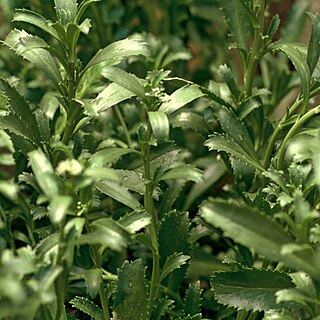
Lepidium banksii, known as coastal peppercress, is a rare species of flowering plant from the family Brassicaceae. It is endemic to New Zealand, formerly found around the coast of the northern South Island but now critically endangered.
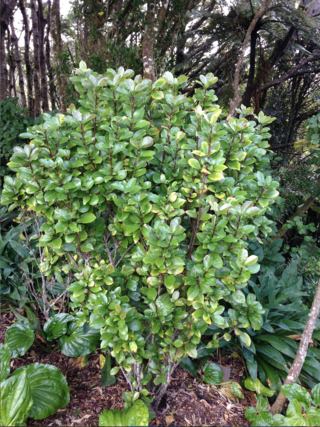
Alseuosmia quercifolia, commonly known as oak-leaved toropapa, toropapa, and karapapa (Māori), is a species of plant in the family Alseuosmiaceae. It grows as a shrub, reaching a height of 2.5 m, and has variably shaped glossy green leaves. Flowering begins in spring, producing fragrant pink flowers which become red berries in Autumn. Endemic to New Zealand, it is found only in the upper half of the North Island - predominately in the Waikato region.

















